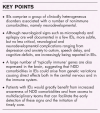Bridging the gap: neurodevelopmental disorder risks in inborn errors of immunity
- PMID: 39374040
- PMCID: PMC11537469
- DOI: 10.1097/ACI.0000000000001036
Bridging the gap: neurodevelopmental disorder risks in inborn errors of immunity
Abstract
Purpose of review: The aim of this review is to examine published reports of neurodevelopmental phenotypes in patients with inborn errors of immunity (IEI). We briefly discuss potential interactions between the immune and the central nervous system and the implications of this crosstalk for current clinical management guidelines.
Recent findings: An increasing number of reports have described neurodevelopmental disorders (NDDs) comorbid with immune-mediated signs. However, the prevalence of this association in IEIs remains unknown.
Summary: IEIs comprise a group of clinically heterogeneous disorders associated with a number of nonimmune comorbidities. Although certain neurological conditions such as microcephaly are recognized as associated features of some IEIs, NDDs are less well described. We reviewed published clinical descriptions of IEIs and found a number of comorbid NDDs in these patients, including autism spectrum disorder (ASD), behavioral deficits, and intellectual disability. Given the lack of uniform assessments for NDDs, we suspect they may be underdiagnosed in IEIs. As NDDs manifest early and can result in life-long cognitive and emotional deficits, which diminish quality of life and increase healthcare utilization, we hope to elucidate relevant pathomechanisms and raise clinician awareness of these comorbidities so appropriate and timely interventions are sought.
Copyright © 2024 The Author(s). Published by Wolters Kluwer Health, Inc.
Conflict of interest statement
References
-
- Akalu YT, Bogunovic D. Inborn errors of immunity: an expanding universe of disease and genetic architecture. Nat Rev Genet 2024; 25:184–195. - PubMed
-
The authors describe the evolution of research on IEIs. They argue that the prevalence of IEIs is closer to 1 in 500 because of underestimation to four factors: underutilization of next-generation sequencing, the overlooked concept of incomplete penetrance, the growing number of IEI patients showing symptoms in other organs (including neurological symptoms), and the impact of somatic mutations.
-
- Kose H, Karali Z, Bodur M, et al. . Neurological involvement in patients with primary immunodeficiency. Allergol Immunopathol 2024; 52:85–92. - PubMed
-
The authors performed a retrospective assessment of 108 patients with PID that presented with central nervous system involvement, found in 99% of the patients (n = 107). The most frequent presentations were cognitive delay (n = 63, 58%), epilepsy (n = 25, 23%), and ataxia (n = 20, 18%).
Publication types
MeSH terms
LinkOut - more resources
Full Text Sources
Research Materials
Miscellaneous


